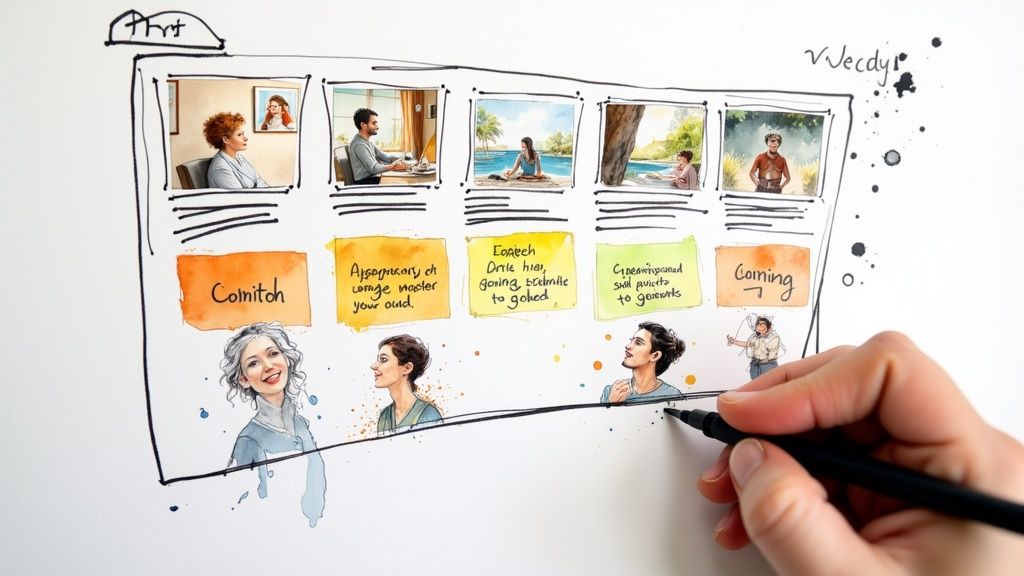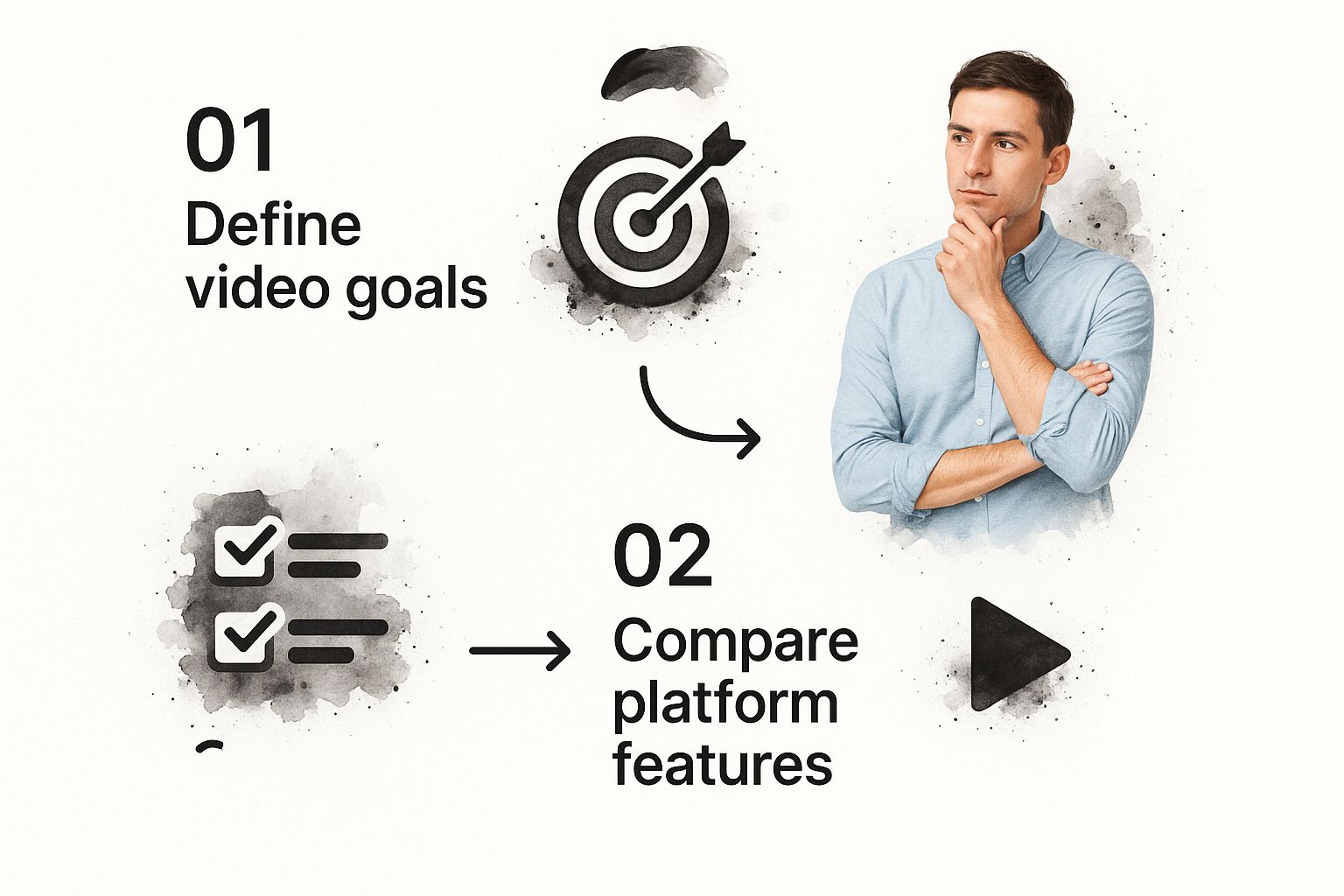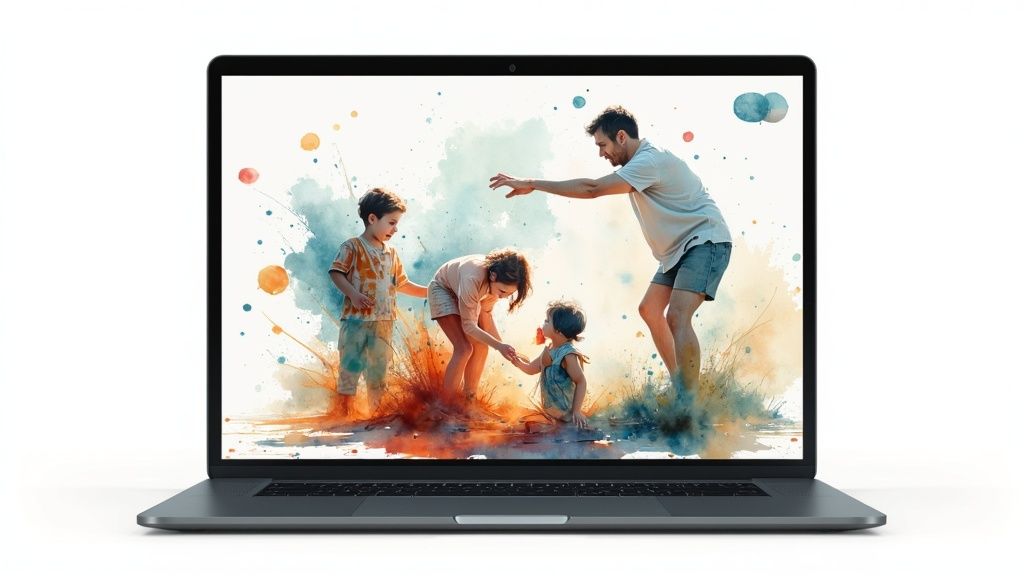Let’s be honest, just putting a video on a page isn't enough anymore. Interactive video is about pulling your audience out of their seat and into the story. It means embedding clickable elements—think hotspots, quizzes, and branching paths—right into your video. You’re handing the controls over to the viewer, letting them steer their own experience.
Why Interactive Videos Drive Better Results
The days of one-way video monologues are over. Viewers today expect to be part of the conversation, not just passive observers. This isn't some fleeting trend; it’s a fundamental shift in how people consume content. Making your videos interactive is no longer a "nice-to-have"—it's a strategic must if you're serious about grabbing and holding attention.

This is where platforms like Aeon come in. The dashboard above gives you a glimpse of how you can layer in these interactive elements, turning a standard video into an actual journey. And the best part? You can track everything. By seeing what people click on and which paths they take, you get a direct line into what truly grabs their interest.
The Psychology of Engagement
So, what's the secret sauce? It all boils down to basic human psychology. We all have an innate desire for control and autonomy. When a viewer can click to choose their own adventure through a product demo or answer a quick poll in a training video, they’re no longer just watching—they’re an active participant.
This simple act of involvement does something powerful in our brains. Instead of information just washing over us, we're actively processing and applying it. The result is dramatically higher information retention and a brand experience that actually sticks.
By transforming viewers from spectators into participants, you create a two-way dialogue that passive content simply can't match. This dialogue is what builds deeper connections and drives meaningful action.
The numbers back this up. We've seen a staggering 200% increase in engagement rates for interactive content since 2021. In e-commerce, product pages with interactive videos see 47% higher engagement. What's more, 64% of consumers say they are more likely to buy after watching one. These aren’t just vanity metrics; they translate to real business impact.
Real-World Performance Comparison
Let’s make this tangible. Picture a standard brand video. Maybe it’s a slick demo of a new software feature. It gets some views, maybe a few likes. But every single person who watches it has the exact same, linear experience.
Now, imagine an interactive version of that same video. A viewer can click on the specific features they care about to see a personalized demo. They can answer a quick poll about their biggest pain points. They can even book a meeting with your sales team directly from the video player.
Suddenly, it’s not just a video; it's a personalized consultation. It doesn't just show the product; it demonstrates its value in a way that's hyper-relevant to each individual. This is how you turn passive views into qualified leads and sales. These are the kinds of powerful https://project-aeon.com/blogs/video-content-marketing-strategies-that-convert that modern brands are built on.
If you’re looking to really nail this, it’s worth exploring different audience engagement strategies to see how you can make your interactive videos even more compelling.
Building Your Interactive Video Blueprint
A killer interactive video doesn’t start with a camera. It starts with a plan.
Before you even think about scripting or shooting, you need a solid blueprint. This plan aligns every choice, click, and branch with a specific, measurable outcome. Jumping into production without this foundation is like building a house without architectural plans—a surefire way to waste time and end up with a confusing final product.
The very first thing you need to do is define your primary goal with absolute clarity. What do you want the viewer to do after watching your video? This objective dictates everything that follows.
- Lead Generation: Is your goal to capture contact information? Then your interactive elements should funnel viewers toward a form or a "Book a Demo" button.
- User Onboarding: Trying to get new customers up to speed with your product? The video should let them click through different features at their own pace.
- Direct Sales: If the objective is a purchase, your video could feature clickable hotspots on products that link straight to a checkout page.
- Customer Education: Are you aiming to answer common questions? A branching FAQ video is perfect, allowing users to pick their specific problem and get an instant video answer.
Mapping the User Journey
With your goal locked in, you can start mapping the viewer's path. Forget linear thinking; this is a web of potential choices. Picture yourself as a guide, creating different routes that all lead toward that main objective you just defined.
Storyboarding is your best friend here. Sketch out each scene and, more importantly, the decision points that connect them.
For instance, in a customer service tutorial, the opening scene might ask, "What issue are you facing today?" The viewer could then see three clickable options: "Billing Inquiry," "Technical Support," or "Account Update." Each choice sends them down a completely different, highly relevant path. This is key because it ensures they only see content that matters to them, which dramatically boosts completion rates. As you map out your blueprint, you can even explore options like integrating voice control and voice-activated interfaces to give users more ways to interact.
Every interactive element has to serve a purpose. If a button doesn't move the viewer closer to the goal or provide them with real value, it's just a distraction.
Here’s a quick guide to help you choose the right tools for the job.
Matching Interactive Elements to Your Goals
| Interactive Element | Description | Best Use Case Example |
|---|---|---|
| Buttons & CTAs | Clickable overlays that prompt an action. | A "Download the eBook" button appears at the end of a marketing video to capture a lead. |
| Hotspots | Invisible clickable areas over objects in the video. | In a retail video, a hotspot over a new handbag takes the viewer directly to the product page. |
| Branching | Viewers make choices that determine the next scene. | An employee training video asks, "How would you handle this situation?" and presents two options. |
| Quizzes & Polls | Questions that pop up to test knowledge or gather opinions. | An educational video about finance includes a short quiz to reinforce key concepts. |
| Data Inputs | On-screen forms for viewers to enter information. | A personalized financial planning video asks for the viewer's age to provide tailored advice. |
Choosing the right interactive elements is all about aligning them with your primary objective. This table should give you a good starting point for brainstorming what will work best for your project.
Crafting a Script for Action
Writing a script for an interactive video is a whole different beast than writing for a standard, linear one. Your script has to actively prompt decisions.
Use clear, direct language for your calls to action. Instead of a vague "Learn More," go for something more compelling like "See How It Works" or "Choose Your Demo."
Your script also needs to account for every possible branch. This means writing dialogue not just for the main path but for every alternate route a viewer might take. The language should feel conversational and guide the user, making them feel empowered by their choices, not overwhelmed by them.
This blueprinting stage is the most critical part of the process. It's the strategic work that ensures your final product is an effective business tool, not just a creative novelty.
Choosing Your Interactive Video Platform
You’ve got a solid blueprint in hand, which is great. Now it’s time to pick the engine that will actually bring your interactive video to life. The good news is that the technology for this has become incredibly accessible. You don't need a team of developers on standby to make something amazing. Modern platforms do all the heavy lifting, freeing you up to focus on the creative side.

A quick glance at software review sites like Capterra shows there’s a whole ecosystem of tools out there, each with its own flavor. The real trick is finding the one that doesn't just fit your budget but also clicks with your specific goals and how comfortable your team is with new tech.
Key Features to Prioritize
Staring at a long list of options can feel a bit paralyzing. The best way to cut through the noise is to zero in on a few essential features. Think of this as your must-have checklist when you're vetting any platform. If a tool nails these basics, you’ll have the power and flexibility to create content that really performs.
Here are the non-negotiables:
- Robust Analytics: You need to see way beyond simple view counts. Look for platforms that track things like hotspot clicks, the paths viewers choose, and how they score on quizzes. That data is pure gold for understanding what works and how to make your next video even better.
- Customization and Branding: Your interactive video is an extension of your brand, and it needs to look the part. The best tools let you tweak everything from colors and fonts to the player controls, ensuring a seamless brand experience.
- Diverse Interactive Elements: Make sure the platform actually supports the cool ideas you mapped out in your blueprint. At a bare minimum, it should handle hotspots, buttons, and branching logic. More advanced options will offer quizzes, polls, and even forms to capture viewer info.
The right platform doesn't just pile on features; it makes your entire workflow simpler. It should feel intuitive enough that your team can build complex, engaging experiences without needing a month of training.
It's no surprise the market for this tech is exploding. Interactive video software was valued at around $5.1 billion in 2023 and is on track to hit $15.4 billion by 2032. This boom is driven by big companies using these tools for everything from corporate training to sophisticated marketing campaigns, and cloud-based platforms have made it accessible for businesses of all sizes.
Finding the Right Fit for Your Team
Beyond the core features, you have to think about what your team actually needs. A nimble marketing duo might fall in love with a platform that offers user-friendly templates and an all-in-one workflow. A massive media company, on the other hand, will likely need enterprise-grade security and deep integration capabilities.
If you want to go deeper on this, we've put together a comprehensive guide to interactive video software.
To frame your decision, ask these three questions:
- Ease of Use: How fast can your team get up and running? Don't just watch a demo—sign up for a free trial and get your hands dirty. A powerful tool is totally useless if it’s too complicated for anyone to actually use.
- Integration Capabilities: Does it play nice with your current tech stack? You’ll want to look for smooth integrations with your CRM, email marketing tools, and analytics platforms to keep your data flowing seamlessly.
- Support and Training: What happens when you get stuck? Solid customer support and a good library of tutorials can be an absolute lifesaver, especially when you're staring down a tight deadline.
Picking your platform is a big decision. By focusing on analytics, customization, and the right interactive elements, you’ll set yourself up to turn that blueprint into a high-performing video that truly connects with your audience and gets you the results you’re after.
Your Production and Editing Workflow
Okay, you’ve got a solid plan and you’ve picked your platform. Now for the fun part: bringing your interactive video to life. This is where all that upfront planning really starts to pay off, turning your storyboard into actual footage.
Filming for an interactive video is a bit different from a standard, linear video. You have to think in terms of multiple paths, not just a single story.
Let's say you're giving the viewer a choice between learning about "Feature A" or "Feature B." This means you need to shoot two separate, complete segments, one for each feature. A pro tip I've learned is to have your on-screen talent leave a natural pause right before a decision point. It gives the interactive element a moment to pop up on screen without feeling jarring, making the whole experience much smoother for your audience.
Filming for Multiple Pathways
Think of yourself as a director juggling a few short, interconnected films. Every branch on your storyboard is its own little narrative. The key is consistency. Make sure your lighting, audio levels, and camera angles stay the same across all these alternate scenes. When a viewer makes a choice, you want the transition to be so seamless they don't even notice it.
The backbone of this whole process is a great script. It’s what keeps all the moving parts from falling into chaos. For a deep dive into crafting scripts that guide viewers toward a specific action, check out our guide on how to write a video script that converts. Getting the script right from the start saves a ton of headaches in editing.
This visual guide breaks down the core process of getting started, from defining your goals to selecting the right tools.

Ultimately, this workflow ensures that your platform choice is directly tied to the specific outcomes you need to achieve.
Adding Interactive Layers with AI
Once your raw footage is in the can, it’s time to head into the edit. This is where AI-powered editors like Aeon really shine because they're built specifically for the demands of interactive content. You’re not just trimming clips and adding music; you’re weaving layers of engagement right into your video timeline.
Let’s walk through a real-world example: an interactive FAQ video for a new software product.
- Initial Setup: You’d start by uploading your main intro clip. In this clip, the host welcomes the viewer and presents three common questions as clickable buttons that appear on the screen.
- Branching Logic: Next, you connect each button to a different video clip. The "Pricing" button links to the segment explaining your pricing tiers, the "Features" button jumps to a product tour, and so on. It's that simple.
- Adding Hotspots: During the product tour segment, you could add invisible clickable hotspots over specific features you're showing. When a viewer clicks one, a little pop-up appears with more details or a link to a help article.
- Creating a Quiz: To make sure your viewers are retaining information, you could drop a quick quiz at the end of a training section. It's a simple way to reinforce key points and keep them engaged.
The real power of interactive editing is transforming a one-way message into a two-way conversation. Every click and choice provides valuable data about what your audience truly cares about.
This whole process turns a passive viewing experience into an active exploration. Your audience isn't just being fed information; they’re discovering it based on what interests them. This kind of active participation leads to way higher information retention and creates a much more memorable brand experience. By following this workflow, you can learn how to create interactive videos that not only grab attention but also drive real results for your business.
How to Launch and Optimize Your Video
You've built it, polished it, and your interactive video is finally ready for the spotlight. It's tempting to think the hard work is over, but hitting "publish" is really just the starting line. What you do next—how you distribute it and analyze its performance—is what separates a cool creative project from a genuine business driver.

Getting the video on your site is simple, but where you put it requires some thought. Don't just bury it on a random page. Think strategically. A slick product demo should live on the product page itself. A powerful customer story will do its best work on a high-traffic landing page. And an interactive FAQ? That could be a game-changer for reducing support tickets inside your help center.
Turning Data Into Action
Once your video is out in the wild, the real fun begins: digging into the data. Your Aeon analytics dashboard is where you'll see exactly how people are interacting with your content. It’s easy to get fixated on total views, but that's a vanity metric. The real gold is in the numbers that tell a story about engagement.
I always tell people to focus on the metrics that actually matter:
- Hotspot Click-Through Rates: Which buttons or on-screen elements are people actually clicking? This is direct feedback on what products or features are grabbing their attention.
- Common User Paths: In a branching video, which storylines are viewers choosing most often? This is invaluable insight for your next content brainstorm, showing you exactly what your audience wants to see.
- Decision Drop-Off Points: Where are you losing people? A high exit rate at a specific choice point might mean your options are confusing or just not compelling enough.
- Quiz Completion Rates: Are people making it to the end of your quizzes? If not, the questions might be too tough, or the quiz itself might be too long.
Your analytics aren't just a report card; they're a roadmap for improvement. Every data point is a clue showing you how to make your next interactive video even more effective.
There's a reason this market is exploding. Interactive content delivers these kinds of valuable insights. The global interactive streaming market is on track to jump from $38.37 billion in 2025 to an incredible $183.99 billion by 2032. That massive growth is happening because consumers now expect to engage, not just watch. Mastering interactive video is how you meet that demand. You can get the full scoop in this interactive streaming market report.
Continuous Refinement Through Testing
Optimization isn’t a one-and-done task; it’s a constant process of refinement. Use the data you’re collecting to run some simple A/B tests and see what moves the needle.
For instance, you could test two different calls-to-action on a button to see which one performs better. Try changing the text from "Learn More" to "See It in Action" and measure the impact on clicks. You could also experiment with different thumbnail images to see which one entices more people to hit play in the first place.
These small, iterative tweaks can add up to huge gains in engagement and conversion over time, making sure your video keeps working hard for you long after you first launched it.
Got Questions About Interactive Video? We’ve Got Answers.
Jumping into interactive video for the first time always kicks up a few questions. I see it all the time. People wonder about everything from the tech side of things to the creative best practices. Getting a handle on these fundamentals is the best way to make sure your first project is a home run.
So, let's clear up some of the most common things people ask when they're getting started.
"Will This Even Work on Our Website?"
This is probably the number one question I hear. Will an interactive video work everywhere? The short answer is yes, as long as you're on a modern browser. Reputable platforms like Aeon generate embed codes that play nicely with all current web standards.
That means your interactive content will look and feel great on desktops, tablets, and smartphones right out of the box—no special tweaks needed.
Another big one is the worry about cost and complexity. It's a common myth that interactive video is way more expensive and time-consuming than a standard production. While that might have been true a decade ago, today's AI-driven tools have completely changed the game, making it accessible for just about everyone.
How Long Should an Interactive Video Be?
This is a tricky one because there isn't a single magic number. My best advice? Keep your individual video segments short and to the point. The total time a person could spend with your video might be longer if they explore a bunch of different branches, but each distinct path should feel quick and concise.
I've found the sweet spot for segments is between 30 and 90 seconds before you present the viewer with a choice. This keeps them leaning in and prevents them from getting bored or feeling like they're stuck in a lecture.
The goal isn't to create a feature-length film. It's to provide a series of digestible, valuable micro-experiences that guide the viewer toward a specific outcome.
Think of it like a real conversation. You wouldn’t just talk at someone for ten minutes straight without letting them get a word in. Your video should work the same way, giving the viewer regular chances to "speak" by making a choice.
Can I Add Interactivity to My Existing Videos?
Absolutely! In fact, this is one of the smartest and most efficient ways to get started. You don't have to go out and reshoot your entire video library. A fantastic strategy is to take one of your top-performing videos and give it an interactive upgrade.
For instance, you could easily add:
- Clickable hotspots over products in a demo video that link right to your product pages.
- A "choose your own adventure" menu at the beginning, letting viewers skip straight to the section they care about most.
- An in-video quiz to a training video to check for understanding and help the information stick.
This approach breathes new life into content you've already invested in. You get a much faster return and can test what resonates with your audience before committing to a bigger interactive production from scratch.
We've put together a quick-reference table to answer a few more common questions we get all the time.
Frequently Asked Questions
| Question | Answer |
|---|---|
| What's the main benefit of interactive video? | The biggest win is engagement. By giving viewers control, you turn passive watching into an active experience, which dramatically boosts retention and conversion rates. |
| Is it hard to track analytics? | Not at all. Platforms like Aeon offer detailed analytics, showing you which paths viewers took, where they dropped off, and how they answered questions. |
| Do I need special software to watch them? | Nope! Interactive videos play in any standard web browser on any device. If you can watch a YouTube video, you can watch an interactive video. |
| Can I use them in email campaigns? | Yes, but with a small twist. You'd typically use a static or animated GIF of the video in the email that links to the full interactive experience on a landing page. |
Hopefully, that clears a few things up and gets you excited about the possibilities.
Ready to stop wondering and start creating? With Aeon, you can transform your existing content or build brand-new interactive experiences from the ground up. See how our AI-powered platform makes it simple to build videos that engage, convert, and deliver valuable insights. Start your free trial today.